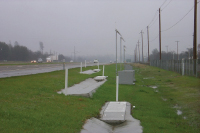Vegetated Treatment Systems
Description
Vegetated treatment systems are also known as biofilters, and can be in the form of strips or swales. Pollutant removal mechanisms include filtration through vegetation, sedimentation, adsorption to soil particles, microbial processes, and infiltration. The primary stormwater constituents removed include total suspended solids (TSS) and total and dissolved metals.Total nitrogen and phosphorus and microbiological constituents may also be removed.
Experience
Caltrans Roadside Vegetated Treatment Sites (RVTS) Study
RVTS Stations

OWP Tasks:
- Assisted in Study Planning
- Reviewed Designs of Monitoring Systems
- Provided Review of Monitoring System Installation Activities
- Provided Monitoring Assistance
- Reviewed Data Assessment and Reporting
OWP Contacts: Maureen Kerner
Caltrans Ornamental Roadside Vegetated Treatment Sites (ORVTS)
The primary objective of the ORVTS study was to evaluate the ability of ornamental/groundcover vegetative species to provide treatment of runoff from Caltrans highways. Runoff from the highway drained into roadside slopes planted with ornamentals and was collected in slotted PVC pipes. Flow from the pipes was measured throughout the storm, along with site rainfall. Flow-weighted samples were collected and composited to assess the water quality from each event at each monitoring station. This water quality was compared to that from edge-of-pavement stations to assess concentration and load reductions.
OWP Tasks:
OWP Tasks:
- Assisted in Study Planning
- Reviewed Designs of Monitoring Systems
- Provided Monitoring Assistance
- Reviewed Data Assessment and Reporting
Caltrans Tahoe Basin Roadside Treatment Sites (RTS)
The goals of the Tahoe RTS study were (1) to determine whether, and how large, a difference in water quality exists between highway edge-of-pavement runoff and runoff leaving the highway right-of-way in sheet flow drainage situations; and (2) to determine the relative effects of different site characteristics on water quality and treatment. Runoff samples were collected from several locations throughout the Lake Tahoe Basin. The locations represented various conditions of highways and right-of-ways in terms of degree and length of slope, amount of obstacles impeding sheet flow (rocks, logs, shrubs, trees, etc.), amount of duff cover, and relative elevation. Slotted PVC pipes were installed within the right-of-way to collect runoff. Edge-of-pavement runoff was collected from double-barreled sand traps. Water quality, including the distribution of small particles (~0.8 to 20 m), was compared among the various stations.
OWP Tasks:
OWP Tasks:
- Assisted in Study Planning
- Reviewed Designs of Monitoring Systems
- Provided Monitoring Assistance
- Conducted Small Particle Distribution Testing and Data Analysis
- Reviewed Data Assessment and Reporting
